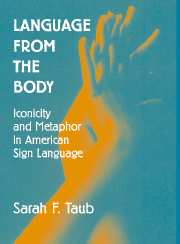Book contents
- Frontmatter
- Contents
- List of Figures
- Acknowledgments
- 1 A Glimpse of the Material
- 2 Motivation and Linguistic Theory
- 3 Iconicity Defined and Demonstrated
- 4 The Analogue-Building Model of Linguistic Iconicity
- 5 Survey of Iconicity in Signed and Spoken Languages
- 6 Metaphor in American Sign Language: The Double Mapping
- 7 Many Metaphors in a Single Sign
- 8 The Vertical Scale as Source Domain
- 9 Verb Agreement Paths in American Sign Language
- 10 Complex Superposition of Metaphors in an American Sign Language Poem
- 11 The Future of Signed-Language Research
- Appendix 1 Glossing Conventions
- Appendix 2 Translation of “The Treasure”
- References
- Index
5 - Survey of Iconicity in Signed and Spoken Languages
Published online by Cambridge University Press: 16 October 2009
- Frontmatter
- Contents
- List of Figures
- Acknowledgments
- 1 A Glimpse of the Material
- 2 Motivation and Linguistic Theory
- 3 Iconicity Defined and Demonstrated
- 4 The Analogue-Building Model of Linguistic Iconicity
- 5 Survey of Iconicity in Signed and Spoken Languages
- 6 Metaphor in American Sign Language: The Double Mapping
- 7 Many Metaphors in a Single Sign
- 8 The Vertical Scale as Source Domain
- 9 Verb Agreement Paths in American Sign Language
- 10 Complex Superposition of Metaphors in an American Sign Language Poem
- 11 The Future of Signed-Language Research
- Appendix 1 Glossing Conventions
- Appendix 2 Translation of “The Treasure”
- References
- Index
Summary
INTRODUCTION
Now that we have a basic understanding of the type of conceptual machinery needed to create iconic linguistic items, let us turn to a survey of the iconic patterns that we can see in signed and spoken languages. This survey focuses on the iconic “tools” that are standard in different languages: the conventional ways in which forms are chosen that preserve the structure of schematic mental images.
In surveying these tools, we will be looking at both “frozen” and productive examples of their use. As we saw in Chapter Three, although the tools can usually combine in a relatively free and productive way, combinations of tools can become established parts of a language's lexicon. I assume here that these no-longer-productive, frozen combinations derived from an earlier, more-productive stage of tool use and I continue to use them as exemplars of the language's tools.
In this survey, we will see both the range of imagery that can be represented iconically by the modality and the range of form parameters that are exploited in these tools. The survey does not present an exhaustive list of the iconic tools of any language; for example, there is no list here of all the ways in which English uses its consonants to represent onsets of sounds. Instead, we will note general principles – for example, the fact that spoken languages do use initial consonants to represent the beginnings of sounds.
- Type
- Chapter
- Information
- Language from the BodyIconicity and Metaphor in American Sign Language, pp. 63 - 93Publisher: Cambridge University PressPrint publication year: 2001



